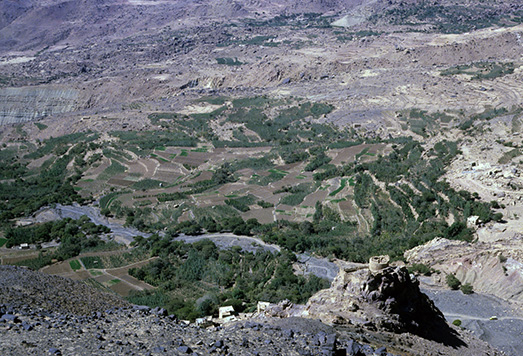
Terraced fields below al-Saraha in valley of al-Ahjur; photograph by Daniel Martin Varisco
by Zaid Ali Alwazir, La Voix du Yemen, June 9, 2013
Agricultural policy describes a set of laws related to the local farming and imported agricultural products from abroad. These laws are supposed to be implemented to get certain results such as utilizing the land, operating it or stabilizing prices of imported and local products.
Since the start of the “youth revolution†in Yemen, talks about the political and economic reforms got increased without focusing on “the agricultural economy†as if it was not part of the general “economyâ€. Therefore, no attention was paid by reformers to this issue since their talks had been focusing on “the material economy†such as “taxesâ€, “Zakat†and others.
“Agricultural economy†is not given the required attention despite the fact that agricultural development would feed the budget with more income, boost up farmers’ capacity to give more and optimize their living standards to ensure their welfare.
However, the government is only interested in revenue collected from them like taxes, Zakat, etc. It never took care of the land or its development to increase production. This would in turn benefit both farmers and Government, as revenue would increase.
This shortsighted vision might be the reason for delaying this problem. Such mentality does not have a strategic plan, but focuses on the day’s needs (your income is your day), rather than the future potential. If they thought well and did well, they would go forward rather than keeping the status quo.
73.5 percent of Yemen’s population is involved in the agricultural sector in the countryside. They either work directly in agricultural activities or in related services and activities that serve the rural and urban residents.
To have better understanding, we must look into the current situation in the agricultural system in Yemen through the historical aspect, particularly what was known as the highlands and lowlands of Yemen. As for the south and east of Yemen, the old system was changed during the socialist era where the whole agricultural system was replaced completely. Unfortunately when Yemen was unified, many violations were committed including land plundering and confiscations and until now I do not know how the situation is. Therefore I will talk now only about the highlands and lowlands of Yemen.
We can say that there is one approach for the implementation of the “agricultural policy†in the highlands and a different one in the lowlands, in line with the theory of the two Islamic schools “-Zaydi†and “Shafi’eiâ€. While the “permanent partnership system†exists in the highlands, the lowlands apply the “renewable lease theoryâ€.
The “permanent partnership system was established to ease the viewpoint of Al-Hadi, “founder of the hadawi – zaydi schoolâ€, in agriculture, which can be shortened into the rule that reads: the land is a property for whoever cultivates it.
This was based on the Islamic rule conveyed by Imam Zaid bin Ali that: (The messenger of God disallowed leasing the land in return for one third or one fourth of the produce. Then he added: “If one of you owns land he should cultivate it himself. If he can’t, he should then give it to a brother who can.†According to this Prophet’s Hadith, the legal rule was formulated stating that: the land is for those who cultivate it. Thus neither partnership nor leasing is allowed but only self-effort is.
If the landlord could not ploughs his land by himself, then another one must possess it, that is if he can farm it in order to utilize as much as possible of the land, by engaging many people, in other words decreasing landlords and increasing farmers.
But this theory was not implemented since it was difficult to apply. Therefore, the Zaydi scholars had to go back to the partnership system. It was the system that prevailed in Yemen’s highlands. It is based on the land given by the owner and the efforts of the farmer (partner). The profit share is done according to the payment percentage. If the landlord paid the whole cost, then the profit is shared equally 50/50. If the farmer (partner) paid some of the cost then he would get two thirds and the remaining one third goes to the landowner. When the partner covers all the cost, then the landowner would only take one sixth and the balance goes to the partner.
So the “permanent partnership system was applied in the highlands while in the lowlands the renewable leasing system†was adopted, according to the relationship of the two sects with their political concepts.
The leasing system (Al-Qibal) in the lowlands is based on fixing the rent annually according to what the landlord decides before the harvesting. That means the leaseholder/farmer must pay the agreed rent regardless of the season’s production. In addition there was a tradition where every leaseholder /farmer has to pay extra cash every year to renew – his lease, as well as offering – the landlord each season some gifts such as a sheep, some ghee or honey.
I remember when the Imam Ahmed released our lands which had been confiscated following the constitutional revolution (note: in 1948), my brother Qassem decided to terminate these extra traditional norms and the renewing of the lease and just get our fair share of the land’s produce. Other landlords got angry and complained to the martyr Hamoud Al-Weshli, the deputy of the Imam. Al-Weshli informed my brother, Qasim that there had been complaints about this. But he did not respond to the complainants.
So, there are two agricultural systems in Yemen, one system provides good status for the partner and another forms a bad situation on the leaseholder. I call for reviewing both systems in order to get some burden out of the landlord from the partner’s share in the highlands, and to decrease the burden on the leaseholder from the landlord’s share in the lowlands for a more balanced and fair system.